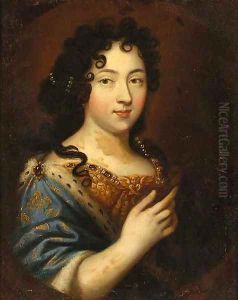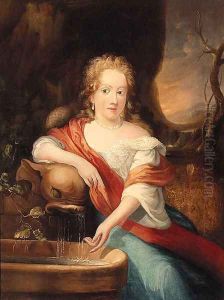Casper Netscher Paintings
Casper Netscher was a Dutch Golden Age painter of the Baroque period, known for his fine and elegant genre works as well as his portraits. Born in Heidelberg, Germany, in 1639 to Polish parents, Netscher's early life was marked by turmoil. His father, a sculptor, died when Netscher was just two years old, and his mother fled with the children to Arnhem in the Netherlands to escape the advancing armies during the Thirty Years' War.
In Arnhem, Netscher was apprenticed to the still-life painter Hendrick Coster, and later he moved to Deventer to study under Gerard ter Borch, a highly respected Dutch artist of the time. Ter Borch's influence is evident in Netscher's early works, which include genre scenes that are similar in style to his mentor's. Netscher's ability to render textures and fabrics with great skill became a hallmark of his work, indicative of his attention to detail and his technical prowess.
Netscher eventually settled in The Hague, where he became a court painter to William III of Orange. His work by this time had shifted towards portraits, where he enjoyed a high reputation. His portraits were sought after by the wealthy bourgeoisie, royalty, and aristocracy across Europe for their refinement and elegance. Netscher was also known for his small-scale history paintings, which reflected a keen interest in the works of the Italian Renaissance and were well-received for their narrative quality and meticulous execution.
Despite his success as an artist, Netscher's life was not without difficulties. He had a large family to support, and his financial situation was often precarious. Nevertheless, he was a prolific artist and left behind a substantial body of work that was highly regarded by his contemporaries and is still studied and appreciated today.
Casper Netscher died in The Hague in 1684. His sons, Theodorus and Constantijn, were also painters and continued their father's artistic legacy. Netscher's works can be found in many prestigious museums around the world, and he is remembered as a significant figure in the Dutch Golden Age of painting, contributing to the era’s rich tapestry of artistic achievement.

